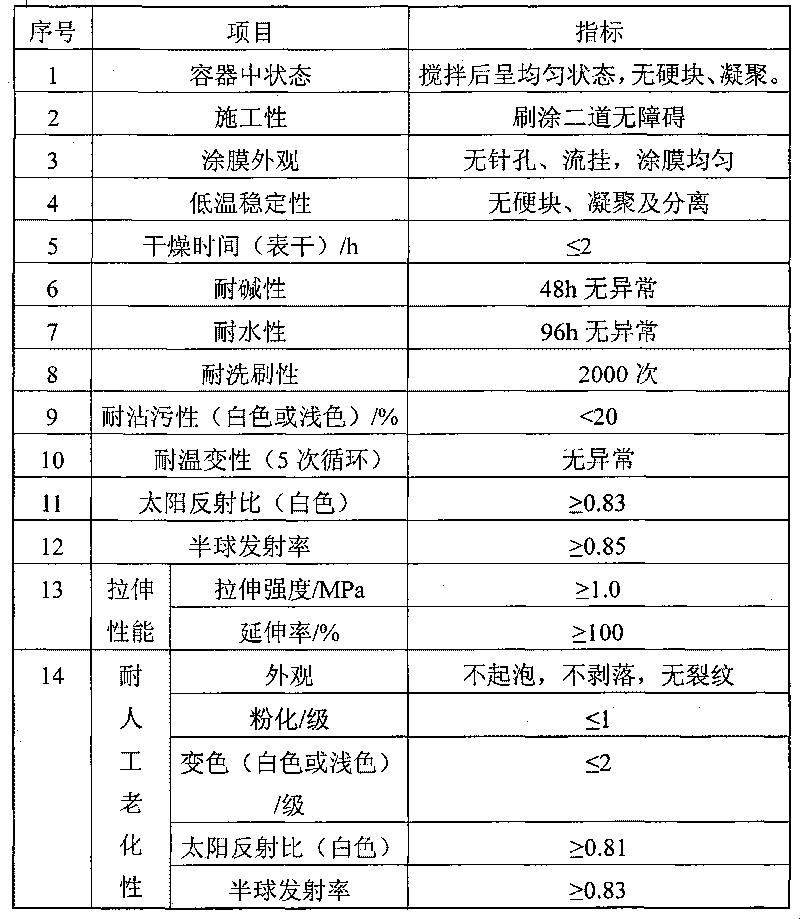Heat reflection paint with hollow glass microballoon
A technology of glass beads and heat reflection, which is applied in the direction of reflection/signal paint, coating, latex paint, etc., can solve the problems of good heat preservation effect, high reflectivity, low thermal conductivity, etc., and achieve low light absorption and high transparency , the effect of high bonding strength
- Summary
- Abstract
- Description
- Claims
- Application Information
AI Technical Summary
Problems solved by technology
Method used
Image
Examples
Embodiment 1
[0058] Top coat (by weight)
[0059] 30 parts of silicone acrylic emulsion, 16 parts of pigment and rutile titanium dioxide, 18 parts of water, 8 parts of nanocomposite functional materials, 12 parts of filler, 8 parts of special high molecular polymer, and 5 parts of additives.
[0060] The preparation method is as follows: weigh the ingredients according to the above formula, sand them with a sand mill until the fineness is qualified after mixing, check the fineness of the slurry with a scraper fineness meter (qualified if it is less than 100 microns), match the color, add 4 parts of hollow glass microspheres, packaged.
[0061] Primer coating (by weight)
[0062] 30 parts of silicone acrylic emulsion, 15 parts of hollow glass microspheres, 5 parts of engineering cellulose, 8 parts of special polymer, 5 parts of spherical closed-cell perlite, 22 parts of water, and 3 parts of additives.
[0063] The preparation method is as follows: weighing each ingredient according to th...
Embodiment 2
[0066] Top coat (by weight)
[0067] 35 parts of silicone acrylic emulsion, 16 parts of pigment and rutile titanium dioxide, 16 parts of water, 8 parts of nanocomposite functional materials, 8 parts of filler, 6 parts of special polymer, and 5 parts of additives.
[0068] The preparation method is as follows: weigh the ingredients according to the above formula, sand them with a sand mill until the fineness is qualified after mixing, check the fineness of the slurry with a scraper fineness meter (qualified if it is less than 100 microns), match the color, add 10 parts of hollow glass microspheres, packaged.
[0069] Primer coating (by weight)
[0070] 32 parts of silicone acrylic emulsion, 12 parts of hollow glass microspheres, 5 parts of engineering cellulose, 8 parts of special polymer, 8 parts of spherical closed-cell perlite, 21 parts of water, 4 parts of additives.
[0071] The preparation method is as follows: weighing each ingredient according to the above formula rat...
Embodiment 3
[0073] Top coat (by weight)
[0074] 40 parts of silicone acrylic emulsion, 16 parts of pigment and rutile titanium dioxide, 18 parts of water, 5 parts of nanocomposite functional materials, 10 parts of filler, 4 parts of special high molecular polymer, 3 parts of additives.
[0075] The preparation method is as follows: weigh the ingredients according to the above formula, sand them with a sand mill until the fineness is qualified after mixing, check the fineness of the slurry with a scraper fineness meter (qualified if it is less than 100 microns), match the color, add hollow 6 servings of glass microspheres, packaged.
[0076] Primer coating (by weight)
[0077] 34 parts of silicone acrylic emulsion, 10 parts of hollow glass microspheres, 5 parts of engineering cellulose, 10 parts of special polymer, 10 parts of filler (spherical closed-cell perlite), 20 parts of water, 3 parts of additives.
[0078] The preparation method is as follows: weighing each ingredient according...
PUM
 Login to View More
Login to View More Abstract
Description
Claims
Application Information
 Login to View More
Login to View More - R&D
- Intellectual Property
- Life Sciences
- Materials
- Tech Scout
- Unparalleled Data Quality
- Higher Quality Content
- 60% Fewer Hallucinations
Browse by: Latest US Patents, China's latest patents, Technical Efficacy Thesaurus, Application Domain, Technology Topic, Popular Technical Reports.
© 2025 PatSnap. All rights reserved.Legal|Privacy policy|Modern Slavery Act Transparency Statement|Sitemap|About US| Contact US: help@patsnap.com

